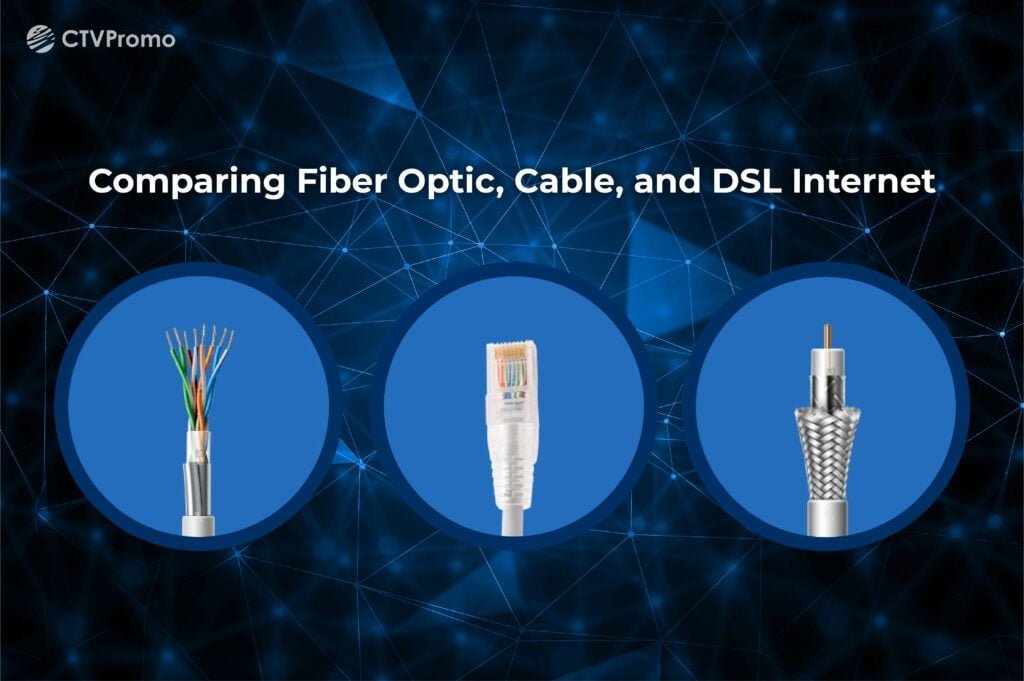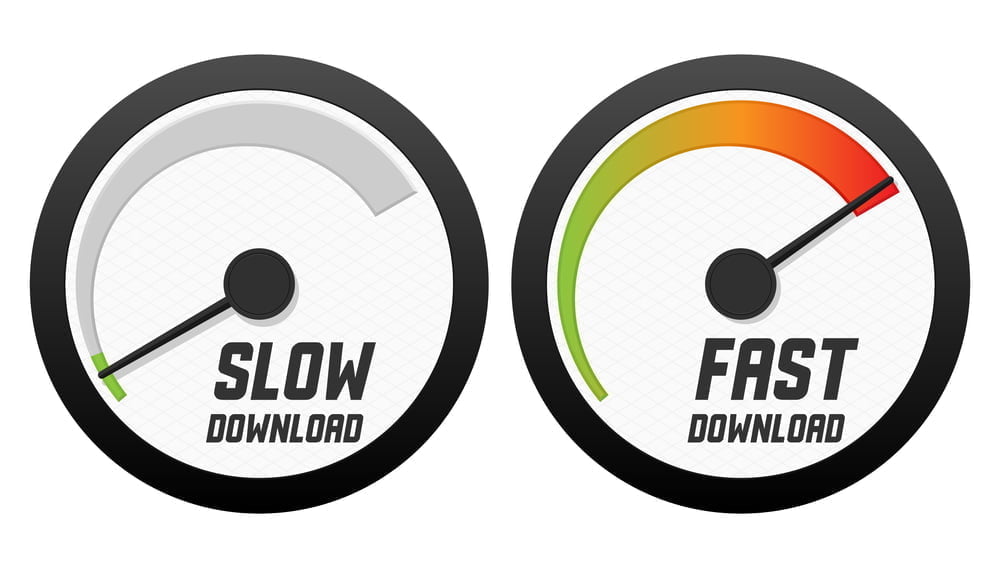On This Page
Home » Blog » Comparing Fiber Optic, Cable, and DSL Internet: Which One is Right for You?
Comparing Fiber Optic, Cable, and DSL Internet: Which One is Right for You?

In today’s fast-paced digital world, having a reliable and high-speed internet connection is no longer a luxury but a necessity. As technology advances, we are presented with various options for internet connectivity, each with its own advantages and considerations.
In this blog, we will delve into the world of internet connectivity and compare three popular options: Fiber Optic, Cable, and DSL Internet.
Whether you’re a streaming enthusiast, a dedicated gamer, or a business professional, finding the right internet solution is crucial.
So, let’s embark on a journey to explore the strengths and limitations of Fiber Optic, Cable, and DSL Internet. We’ll ultimately discover which one is the perfect fit for your unique needs.
Get ready to make an informed decision that will transform your online experience and unlock a world of possibilities!
What is Fiber Optic Internet?
Fiber Optic Internet is an advanced technology that uses thin strands of glass or plastic to transmit data through pulses of light.
It offers incredibly fast and symmetrical speeds, making it ideal for bandwidth-intensive activities like streaming, online gaming, and large file transfers. Fiber Optic Internet provides reliable and consistent performance, even during peak usage hours.
Example Providers:
What is Cable Internet?
Cable Internet utilizes the existing cable TV infrastructure to deliver internet connectivity.
It offers high-speed internet through coaxial cables, providing faster speeds compared to DSL. Cable Internet is widely available and offers a good balance between speed and affordability.
It is suitable for activities like streaming videos, browsing, and online gaming.
What is DSL Internet?
DSL (Digital Subscriber Line) Internet operates over traditional telephone lines.
It delivers internet connectivity through copper wires and offers reliable speeds for basic internet needs. DSL is widely available and more affordable compared to fiber and cable options.
It is suitable for light internet usage such as web browsing, email, and social media.
Example Providers:
Comparing Fiber Optic, Cable, and DSL Internet
When choosing an internet connection, it’s crucial to understand the differences between Fiber Optic, Cable, and DSL Internet.
Let’s dive into a detailed comparison of these three options.
Speed and Bandwidth
Let’s explore the speed and bandwidth of each of these internet types.
- Fiber Optic Internet:
- Blazing-fast speeds: Fiber Optic offers the highest speeds among the three, reaching up to 1 Gbps (Gigabits per second) or even faster.
- Symmetrical bandwidth: With Fiber Optic, both upload and download speeds are equally fast, making it ideal for activities like streaming, gaming, and large file transfers.
- Cable Internet:
- High speeds: Cable Internet provides fast download speeds, typically ranging from 25 Mbps to 300 Mbps. However, upload speeds are usually lower than download speeds.
- Asymmetrical bandwidth: Cable connections offer higher download speeds compared to upload speeds.
- DSL Internet:
- Moderate speeds: DSL offers moderate download speeds ranging from 5 Mbps to 100 Mbps. However, the actual speeds may vary depending on the distance from the provider’s central office.
- Asymmetrical bandwidth: Similar to Cable Internet, DSL connections also have higher download speeds compared to upload speeds.
Reliability and Stability
Here’s a comparison of the reliability and stability offered by Fiber, Cable, and DSL internet.
- Fiber Optic Internet:
- Highly reliable: Fiber Optic is known for its reliability and stability, providing consistent speeds even during peak usage hours.
- Less susceptible to interference: Fiber Optic cables are not affected by electrical or radio frequency interference, ensuring a stable connection.
- Cable Internet:
- Reliable with occasional congestion: Cable connections are generally reliable, but speeds may be affected during peak usage times when multiple users in the area share the same cable line.
- DSL Internet:
- Reliability varies: DSL reliability can vary depending on the distance from the provider’s central office. Users closer to the office tend to experience more stable connections.
Availability
Let’s compare these internet types in terms of their availability around you. Because as soon as you get to know these internet services, you will be asking questions like ‘Where can I find fiber optic internet near me?’
- Fiber Optic Internet:
- Limited availability: Fiber Optic infrastructure is still being expanded, and it may not be available in all areas. It is more commonly found in urban or select residential areas.
- Cable Internet:
- Widely available: Cable Internet is widely available, with coverage in many urban and suburban areas. It may not be as accessible in rural or remote regions.
- DSL Internet:
- Widely available: DSL is one of the most widely available internet options, as it utilizes existing telephone lines. It can be found in both urban and rural areas.
Upload and Download Speeds
Here’s an insight into the relative speeds offered by these internet types.
- Fiber Optic Internet:
- High upload and download speeds: Fiber Optic offers symmetrical speeds, providing equally fast upload and download rates. This is beneficial for activities that require both, such as video conferencing and cloud storage.
- Cable Internet:
- Moderate to high download speeds: Cable connections offer fast download speeds, but upload speeds are comparatively slower. This makes it suitable for activities like streaming and online gaming, where high download speeds are crucial.
- DSL Internet:
- Low to moderate upload and download speeds: DSL connections provide lower upload and download speeds compared to Fiber Optic and Cable. It is suitable for basic internet usage, such as web browsing and email.
Price
The ultimate factor behind choosing any service is the total cost that you need to bear, so let’s look into it.
- Fiber Optic Internet:
- Higher cost: Fiber optics tends to be more expensive than Cable or DSL. However, prices may vary depending on the provider and package options.
- Cable Internet:
- Moderate cost: Cable Internet offers a good balance between speed and affordability, making it a popular choice for many households.
- DSL Internet:
- Lower cost: DSL is generally more affordable than Fiber Optic and Cable, making it a budget-friendly option for users

Suitability for Different Internet Usage
The flexibility of internet service is another factor that differentiates across multiple internet facilities.
- Fiber Optic Internet:
- Bandwidth-intensive activities: Fiber Optic is perfect for users who engage in bandwidth-intensive activities like streaming 4K videos, online gaming, and large file transfers.
- Multiple connected devices: It can easily handle multiple devices simultaneously, making it suitable for households with several users and smart devices.
- Businesses and professionals: Fiber optics is preferred by businesses and professionals who require fast and reliable internet for tasks such as video conferencing, cloud storage, and data transfer.
- Cable Internet:
- Streaming and online gaming: Cable Internet is well-suited for streaming high-definition videos and online gaming, providing a smooth and uninterrupted experience.
- Moderate Internet usage: It caters to users with moderate internet needs, such as web browsing, social media, and occasional video conferencing.
- Small to medium-sized households: Cable Internet is suitable for small to medium-sized households with a moderate number of connected devices.
- DSL Internet:
- Basic Internet usage: DSL Internet is ideal for users with basic Internet requirements, including web browsing, email, online shopping, and social media.
- Single users or small households: It is well-suited for single users or small households with minimal simultaneous device usage.
- Budget-conscious individuals: DSL offers an affordable option for users who prioritize cost-effectiveness over ultra-fast speeds.
Here’s a brief overview of the pros and cons of Fiber Optic Internet, Cable Internet, and DSL Internet:
| Pros and Cons | Fiber Optic Internet | Cable Internet | DSL Internet |
| Pros | – Blazing fast speeds and symmetrical bandwidth. | – High speeds suitable for streaming and online gaming. | – Widely available in many areas. |
| – Reliable and consistent performance. | – Wide availability in many regions. | – Affordable and cost-effective option. | |
| – Suitable for bandwidth-intensive activities. | – Faster than DSL in many cases. | – Good option for basic internet usage. | |
| – Minimal latency and lag, ideal for online gaming. | – Can handle multiple connected devices. | ||
| – Scalable for future internet needs. | – Can offer bundled services like TV and phone. | ||
| Cons | – Limited availability in some areas. | – Speeds can slow down during peak usage times. | – Slower speeds compared to Fiber and Cable. |
| – Generally higher cost compared to other options. | – Upload speeds can be slower than download speeds. | – Performance may vary depending on distance from the provider. | |
| – Speeds can be affected by the number of users in the area. | |||
| – Connection quality can be affected by the cable infrastructure. |
It’s important to consider these pros and cons when making a decision about your internet service provider.
Which Internet Connection is Right for You?
Consider factors such as your internet usage requirements, budget, and availability when choosing the right internet connection for your needs.
- Fiber Optic Internet: Ideal for users who require ultra-fast speeds and engage in bandwidth-intensive activities like 4K streaming, online gaming, and large file transfers.
- Cable Internet: Suitable for users who prioritize a balance between speed and affordability, and engage in activities like streaming videos, browsing, and online gaming.
- DSL Internet: Recommended for users with basic internet needs such as web browsing, email, and social media, at a more affordable price point.
Key Takeaways
Here’s a summary of the comparison between Cable, DSL, and Fiber optic so that you can choose the one that fits your needs the best.
| Factors | Fiber Optic Internet | Cable Internet | DSL Internet |
| Speed | Very High | High | Moderate |
| Bandwidth | Symmetrical | Asymmetrical | Asymmetrical |
| Reliability | Highly Reliable | Reliable | Reliable |
| Availability | Limited Availability | Widely Available | Widely Available |
| Upload Speed | High | Moderate to High | Low to Moderate |
| Download Speed | High | Moderate to High | Moderate to Low |
| Price | Higher Cost | Moderate Cost | Lower Cost |
| Suitable for | Bandwidth-Intensive Activities | Streaming, Browsing, Gaming | Basic Internet Usage |
All in all, choosing the right internet connection depends on your specific needs and usage requirements.
Fiber Optic Internet offers unmatched speeds and symmetrical bandwidth for bandwidth-intensive activities. Cable Internet strikes a balance between speed and affordability, making it suitable for streaming and moderate internet usage. DSL Internet provides a budget-friendly option for basic internet needs.
People also read
-
 Understanding Different Internet Speeds and Choosing the Right Plan for Your NeedsJune 15, 2023/0 Comments
Understanding Different Internet Speeds and Choosing the Right Plan for Your NeedsJune 15, 2023/0 Comments -

-
 Exploring the Benefits of Unlimited Data PlansJune 22, 2023/
Exploring the Benefits of Unlimited Data PlansJune 22, 2023/ -

-

-

-

-

-













